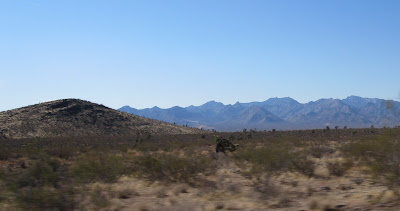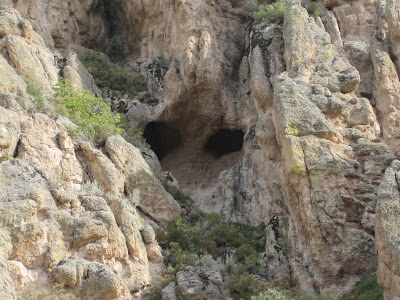This is a continuation of my retracing George Q. Cannon’s 1849 journey.
November 9, 1849 (Friday):
Flake and Smith Companies (Meadow Valley Wash: Lyman Crossing to above Leith):
“At day light,” Charles Rich took J. Henry Rollins and one other man to “a high rise two miles west” to look for “prospects for water” (they ultimately found none). About the same time, as the rest of the camp awoke, “they found that their “mules and horses was scattered in every direction.” One of the men that had not made it to camp the night before arrived that morning. While Brother Rich was still out in search of water, the two companies “left camp and traveled up the bed of the creek”[1] “northward, expecting to find water at the mountains.”[2] Below, Lyman Crossing, looking north to the canyon in Meadow Valley Wash.
When Brother Rich returned to camp, he “found both companies” had “started up the creek” without waiting for his observations or his “council.”[3] “The weather was very warm for the season, and, after the sun arose, its rays felt oppressive.” Before they “reached the mouth of the canyon, about eight miles distant, above Leith, one of the brethren became almost crazy with thirst.” He ultimately resorted “to the dreadful expedient of drinking his urine.” However, instead of quenching his thirst, “it had the very opposite” effect. “It made him more thirsty, and almost maddened him. There were several of Smith’s men also whose reason was nearly upset through their excessive thirst. There were a number of the animals belonging to Captain Smith’s company which ‘gave out,’ as well as some” of Flake’s company. “It seemed as though” they “would never reach the canyon for which they were aiming. The distance was not very great, and men with plenty of food and drink would have soon traveled it.” But they “were all weak,” and did not eat “for fear of increasing” their thirst. They “found it difficult to drag” themselves “through the sand in the bed of the creek. The travel of that morning tested the endurance of all very thoroughly and the company straggled along in a broken condition. The men on the lead reached the canyon a long time ahead of those who were behind. After proceeding up the canyon a little distance
they found running water.
As soon as they saw it they shouted ‘water, water’ at the top of their voices. The cry was caught up by those behind,” and was “repeated the whole length of the line.” This news “infused new life” into the men, and they “pushed forward with increased energy. Some of them were so long, however, in reaching the water, that an impression began to prevail among them that they had been deceived. But they reached it at last. Pure, sparkling, cold water was there, gurgling as it ran over the rocks in the channel.”
It was “not a large stream, but it was sufficient.” They “rushed eagerly to the stream and stretched at full length on the ground, slaked” their “thirst by copious draughts taken at such intervals as not to hurt” them. They named the place Providence Canyon as the finding of the water had been “providential.” It appears that they were in Meadow Valley Wash, a bit north of Leith.[4]
George Cannon later noted:
A body of water as large as Lake Superior could not have produced more joy or thankfulness. I thought that morning, and many times during that journey, that I would never cease to be thankful for the precious gift of water. Though nearly twenty years have elapsed since then, the impression still remains; I cannot bear now to see water wasted.[5]
Henry Bigler was of the Flake company that struggled in the rear. After about three miles, one of his animals gave out. He “left her and put the pack” on the animal he rode. This remaining animal had also nearly given out and Bigler knew he would be “late in getting into camp” as it took him “much labor” to “get her along.” Brother Keeler, who had wounded his foot two days previous, was told by Bigler to “go ahead with the camp, and if they found water to send” someone to meet him “with a canteen full of water.” Bigler “was soon left behind without any arms and no one knew” he “was so far behind.” He “frequently scratched holes in the sand for water and chewed bullets to make moisture” in his mouth. About 3:00 p.m., he saw “Brother Cain coming” with a “tin cup” glistening “in his hand.” He raised his hand and shook it. Bigler “understood the sign.” When they met, Cain handed Bigler a “canteen” and Bigler drank “every drop.” Bigler’s mouth “began to feel bitter” and he “began to feel like vomiting. It was not far to camp” and when Bigler arrived “supper was ready.” By the time Bigler had eaten, “two of the men who had overtaken” them the day before “came in on foot, leaving the other four behind with their animals.”[6] These two had “pushed ahead with the hope of finding water that they could carry back” to the other four.” After eating, these two men, started back in search of their four comrades.[7] They were accompanied by Henry Bigler, in search of his mare,[8] and “two of Smith’s company” that had also left a horse behind.[9] When they came upon Bigler’s mare, the other four men helped him pour “a canteen full of water down her throat.” The two in search of their four comrades continued back “with their canteens of water”[10] and the two in Smith’s company continued on in the search for their horse,[11] while Bigler returned to camp alone. “It was sometime after dark” when Bigler got back to camp with his mare.[12] Later, the two in search of their four comrades returned after an unsuccessful search. The two members of Smith’s company also returned after an unsuccessful search for their horse. However, they had seen “a band of Indians, about twenty-two or twenty-three in number, three of whom had rifles.” The men in camp “were afraid the Indians had lain in ambush and killed the four men as they passed through one of the narrow canyons”[13] they had to “descend.”[14] They traveled 10 miles that day.[15]
November 10, 1849 (Saturday):
Flake and Smith Companies (Meadow Valley Wash: above Leith):
There were “orders to lay in camp all day.” Henry Bigler and “two or four others took charge of the animals to herd them” to the “best pasture.”[16] Five of the Flake company, including George Cannon, and “five of Captain Smith’s” company, along with the two men who were missing their four comrades, went back to “search for some traces” of the four men. They “armed” themselves and “started afoot,” each taking “a canteen of water apiece.” They “also took a spade” with them so that they could give the four men a “decent burial” if they should find them murdered. To their “great relief,” they found the men and their horses about four or five miles from camp. “They had wandered from” the “trail in search of water and had found some in a cave eight miles below” their camp the night before. They were “so pleased to find them” that, when they “neared the mouth of the canyon,” they “whooped and some fired off their guns with the intent of informing the companies that the men were safe.”[17] Several men from camp “went to their assistance,” expecting that the search party had been attacked by Indians.[18] Others “supposed the camp” was under attack and “seized their guns” and took “measures” for their “defense.”[19]
ENDNOTES:
[1] Rich states he took two men (but does not name them) to a “high rise”; Bigler states it was Rich and Rollins and that they went to a “mountain” and did not find prospects for water; Rich’s directions have been incorrect for several days and his “west” may be “south” if he was being consistent with his other directions.
[2] Farrer; Rich indicated they were traveling east, but his directions the day before also appear to have been incorrect.
[3] Rich
[4] Landon, Michael N. (editor), The Journals of George Q. Cannon, Volume 1, To California in '49, (Deseret Book Company, Salt Lake City, Utah: 1999), pp. 86, 105; Hafen and Hafen state that an early wagon road followed Toquap Wash from Bunkerville about 20 miles to “the pockets,” then turned east to Tule Spring. The road then went north to enter the Meadow Valley Wash at Gann’s ranch, a few miles below Elgin. They believe the site of Providence Creek was at Gann’s ranch. Hafen, LeRoy R. and Hafen, Ann W. Journals of Forty-Niners, Salt Lake to Los Angeles: With Diaries and Contemporary Records of Sheldon Young, James S. Brown, Jacob Y. Stover, Charles C. Rich, Addison Pratt, Howard Egan, Henry W. Bigler, and Others, Glendale: Arthur H. Clark. 1954 (49ers), pp. 155 and 157, nn. 23 and 24; Perkins believes they turned north and west from Toquop Wash, crossed through Tule Valley and came onto Meadow Valley Wash between Carp and Leith Sidings on the Union Pacific railroad. After following the wash a short distance, they reached Providence Creek. Perkins, George E. Pioneers of the Western Desert: Romance and Tragedy Along the Old Spanish or Mormon Trail and Historical Events of the Great West, Los Angeles: Wetzel Publishing Co. 1947, pp. 46-47.
[5] Cannon; Bigler states that “both men and animals drank greedily for all had suffered.”[6] Bigler
[7] Cannon
[8] Bigler
[9] Cannon
[10] Bigler
[11] Cannon
[12] Bigler
[13] Cannon; These Indians were the Panaca subgroup of Southern Paiute Indians. (Indian Handbook, p.
[14] Farrer
[15] Bigler and Farrer; Rich stated 12 miles.
[16] Bigler
[17] Cannon[18] Bigler
[19] Cannon
































































